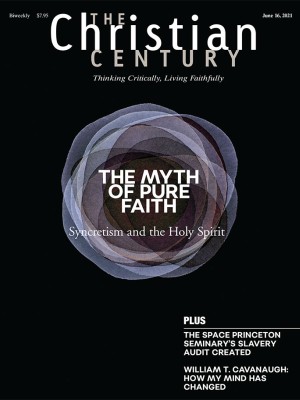How White Christians turned syncretism into an insult
Early-20th-century European and North American missionaries grew concerned about it—but never in their own churches.

Theology doesn’t have many insults. This is a good thing, because insults diminish another’s humanity and make light of the Creator of that humanity. I take it as a positive sign for the health of Christian theology that it has so few of them.
In recent years, however, syncretism has become one such derogatory term. What it implies may include “Your Christianity doesn’t seem pure,” “Your Christianity is less refined than mine,” or “Your Christianity feels exotic to me.” It nearly always comes down to “Your Christianity makes me feel uncomfortable.”
Read our latest issue or browse back issues.
It wasn’t always this way. For centuries, syncretism was something to aspire to. This makes it different from heresy, theology’s other epithet, which has never been a compliment. Syncretism was long used to express admiration for the ability to form alliances across ecclesial divisions. It only became pejorative in the early 20th century. Our insults tell us a lot about ourselves, and the Holy Spirit often works through our feelings of discomfort. Reevaluating how we think about syncretism may open up our understanding of the Spirit.
The evolution of syncretism tells a larger story about Christianity over the last few centuries. It’s a story about racism and how that racism has constrained and imperiled our understanding of divine revelation. During the 19th and early 20th centuries, the term syncretism got mixed up with White Christianity’s anxieties about its own purity, as White Christians began encountering more religious expressions outside of Europe and North America.
In the 16th century, before syncretism was an insult, Erasmus of Rotterdam wrote a letter to Philip Melanchthon. Worried about increased fracturing between Christian churches, the Catholic humanist wrote to the Lutheran Reformer: “You see how the hateful conspire against good learning. It is better that we syncretize. Concord is a mighty rampart.” Here syncretism signifies prudent cooperation during a fractious time. Similarly, Zwingli promoted syncretism among Swiss Reformed churches. Martin Bucer also called his ecclesial negotiations syncretism.
The word gained something of its caustic quality during the 17th century, in a fierce Lutheran debate between Georg Calixtus and Abraham Calovius. Calixtus sought unity with other churches through a minimal expression of doctrine; Calovius fought back by accusing Calixtus of abandoning Lutheranism and the Augsburg Confession. Calovius called Calixtus’s writings “the excrements of Satan” and said his syncretism had no place in Lutheranism. This debate became known as the syncretistic controversy, and people began using the word syncretism to express their worries about Christian purity.
While Calovius added a derisive connotation to the word, in much of Christianity it remained a compliment describing an aspiration for coalition building. By the late 19th century, however, syncretism shifted toward a neutral connotation, referring simply to a mixture with another religion or with cultural surroundings.
It wasn’t until the early 20th century in Christian missionary circles that the word became clearly negative. At this point, White Christians began learning about religious practices in other parts of the world, in part through correspondence with European missionaries. As Christianity spread rapidly, missionaries and theologians began worrying that Christianity could get polluted by non-European influences. They started calling supposedly diluted forms of Christianity syncretism.
Meanwhile, in anthropology and the new field of religious studies, scholars continued using the word in a neutral sense. Many pointed out that every religious tradition blends with its cultural surroundings, and thus syncretism is unavoidable. In the early 20th century, scholar Melville Herskovits saw the resilience of African religious practices in the New World—now being expressed in Christianity—and called it syncretism.
The contrast was stark. While an anthropologist used the word syncretism to show the enduring power of African cultures across the Middle Passage and amid centuries of enslavement and racism, White Christian theologians used it to deride forms of Christianity they found inferior to their own.
Missionaries and theologians did not speak explicitly about syncretism in terms of race, but the connection was clear. During this period, forms of Christianity dubbed as syncretism were almost entirely from beyond Europe and North America. At the 1910 World Missionary Conference in Edinburgh, for example, missionaries spoke of modern syncretism only in Japan, Africa, and India. At the 1928 World Missionary Conference, delegates expressed concern about syncretism among “younger churches” but not European ones. In many years of studying how Christians used the word syncretism during this era, I’ve struggled to find places where White Christians used it about themselves.
This worry about purity shaped how Christians understood revelation. White Christianity saw itself as the norm and as the primary bearer of divine revelation. It did not expect to discover something new through different cultures’ encounters with Christ. Rather, these cultures were expected to conform to largely White understandings of Christianity. The closer one came to White expressions of Christianity, the less likely one would be dubbed a syncretist. In this way, racism inhibited comprehension of divine revelation by narrowing its scope.
After syncretism became firmly entrenched as a theological insult, outside of theology its connotation changed again. Among anthropologists in the 1990s, syncretism was celebrated as the reshaping of Christianity from an imperial religion into a means of resisting colonialism. Syncretists showed creativity by blending Christianity with indigenous traditions. They carried wisdom from these traditions into a new Christian idiom. Syncretism’s pejorative past became a virtue, because the term could acknowledge past disparagement while praising the very thing that missionaries and theologians had scorned.
Meanwhile, biblical scholars also recognized dissonance between syncretism’s varying associations. Many found themselves caught between the theologians who saw syncretism as an insult and the religious historians and anthropologists who saw syncretism as inevitable. In scripture, biblical scholars found all sorts of syncretisms. Ancient Israelites borrowed rituals and understandings of God from Canaanites. Paul borrowed from Stoicism in his theology and ethics.
These instances of syncretism weren’t one-dimensional. Scholars found that Israelites could borrow the quality of mercifulness from the Canaanite god El while leaving aside the polytheism associated with El. They noted that Paul could quote from Stoics when speaking of God as one through whom “we live and move and have our being” (Acts 17) while leaving aside other aspects of their thought.
These examples show how material culture becomes embedded in narrative texts. For example, Jesus didn’t die an abstract death that could have happened anywhere. The context of his death at the hands of the Roman imperium is not some husk of the gospel that might be forgotten once a Christian has internalized the cross’s salvific message (even if some atonement theories work that way). Rather, the historical context of the cross becomes part of the revelation itself. Jesus’ death at the hands of the Roman imperium was in part a repudiation of oppressive and violent imperial rule. Specific cultures and specific histories become absorbed into the stories of scripture. Culture—and the syncretism that comes from engaging with it—becomes part of the data of revelation.
Amid changing associations of syncretism, the reality is that all Christians mix their culture with their faith and its practices. Well after syncretism became pejorative, theologians from Madathilparampil Thomas to Leonardo Boff recognized the dissonance between syncretism being an epithet and syncretism being inevitable. We all syncretize.
Pastors know this intuitively. We constantly look for links with a congregation’s culture to shape how we preach and lead. We just aren’t accustomed to calling it syncretism.
In Swahili there are two words for inculturation, and the contrast between them portrays the challenges of syncretism while also providing a way through them. One word for inculturation is utamadunisho, which indicates importing something foreign into a culture. By this account, as Christianity enters a new place it is comparable to a commodity. It might be used differently in the new setting, but the thing itself stays the same. The other word for inculturation is umwilisho. Translated literally, it means “body-making”: it takes the Swahili word for body and turns it into a verb.
Each of these words corresponds to a way of viewing syncretism. In the view reflected in utamadunisho, the gospel is a freestanding entity that does not depend on the history and culture of any particular place. The gospel can be transplanted from one culture to another without undergoing significant change, because new cultural expressions of Christianity are considered ancillary to its core and the core of Christianity never changes.
In this view, syncretism becomes an insult because it represents an understanding of Christianity’s core as cultureless. Seeing the gospel as freestanding from culture, however, retains the troubles of Whiteness in Christianity. This is because aspects of faith seen as essential to the gospel are often formulated and reformulated in Europe. For instance, someone might see penal substitution as central to the gospel without realizing that this view of atonement is now tied to an individualism honed in Europe and North America. While such forms of Christianity see themselves as independent of culture, they usually carry White European Christianity as their implicit assumption.
Another problem with this approach is historical. It doesn’t recognize that sometimes the claims of Christianity expand over time through syncretism. The word homoousios in the Nicene Creed, which we translate as “of one being” or “of one substance,” was once a syncretism from Gnosticism. The term was rejected by a church council in Antioch during the third century. Some decades later, the word homoousios was retooled and made its way into creedal Christianity. The view of Christianity and culture reflected in utamadunisho doesn’t have an explanation for instances when a syncretism like homoousios becomes an orthodoxy.
Umwilisho, on the other hand, has a livelier quality. It recognizes that Christianity adapts as it moves from one place and culture to another. Translation is not simply a neutral exercise; it can generate new insights. (The acceptance of homoousios depended in part on the gospel’s translation from Aramaic into Greek.) In umwilisho, this process continues happening over time. While European missionaries first characterized African reverencing of ancestors as a pagan practice, now Christians in Africa are showing how regarding Christ as an ancestor enlarges our understanding of Christ and the communion of saints.
This approach sees the scope of Christianity not only growing in the course of history but doing so through cross-cultural encounters. Christ’s body is an intercultural body. It builds up as more and more people are baptized into it. Christ’s body is being enfleshed across time and space through our cultured bodies.
Our syncretized Christianities help shape the body that is Jesus himself. Those third-century Gnostics bringing resources into Christianity led to a moment of umwilisho—a moment when Jesus’ body grew as Christians discovered more of Jesus through the resources of another culture. Seeing Christ as an ancestor is another moment of umwilisho.
But not just any syncretism is considered appropriate by this account. Some syncretisms harm Christianity, and indeed some are abominations. White nationalists erecting a wooden cross at the United States Capitol during their insurrection earlier this year was a syncretism, blending Christianity with a vision of White America.
The problem that became vivid during the insurrection wasn’t just syncretism, since all of us syncretize. The problem was the specific kind of syncretism that showed up. It was a syncretism that degrades Jesus’ sacrifice on the cross and wounds Christ’s very body. While liberal Christians may be tempted to use the term syncretism as an insult when applying it to someone else, this obscures the fact that we all syncretize. It doesn’t help us face the challenges of racism and revelation that accompany syncretism.
In Swahili, umwilisho means both inculturation and incarnation. This double meaning allows umwilisho to help us envision the incarnation of Jesus as continuing across time and space, rippling through many cultures and eras. In this regard, umwilisho is a theological category of great promise, as the African Catholic scholar Laurenti Magesa has shown.
Through umwilisho, the Spirit sometimes shows us something about Jesus that we haven’t seen before. We aren’t likely to see something that contradicts what Jesus revealed in the first century, but we can expect that what Jesus revealed in the first century does not exhaust the fullness of Christian revelation. As Jesus told his disciples, “I still have many things to say to you, but you cannot bear them now. When the Spirit of truth comes, he will guide you into all the truth” (John 16:12–13).
Incarnation continues as the Spirit builds up Christ’s body over time. Holding on to a supposedly pure form of Christianity, however, imperils our ability to see the revelation that is given to us. White Christians’ feelings of comfort should
not be the barometer for whether the church incorporates a particular syncretism. After all, we are living in a time of tremendous theological promise, especially given Christianity’s growth in recent centuries. Umwilisho continues around the world. Through history, the incarnation carries on.
A version of this article appears in the print edition under the title “Theology’s insult.”






